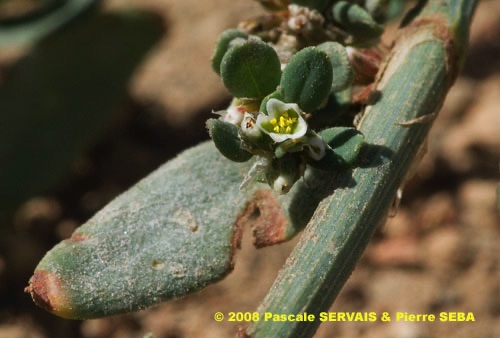
Polygonum aviculare L.
Fam. : Polygonaceae
© Pascale SERVAIS & Pierre SEBA, 2018. Tilo Botanica: Flore de Tilos et du Dodécanèse / Flora of Tilos and of the Dodecanese
English translation by Brenda Bradbury, Howard Bradbury and Stéphane Léonard
Plante herbacée, ligneuse à la base, à tiges rampantes à étalées, glabres ou presque glabres, cylindriques, striées, longues, grêles, de 1 à 1,5 mm de diamètre, plus ou moins feuillées jusqu’au sommet.
Feuilles présentes, alternes, simples, ovales, elliptiques ou lancéolées, entières, poilues, planes, de 10 à 40 mm de long, à gaine membraneuse brunâtre (ochréa), lacérée au sommet, avec 4-6 nervures, embrassant la tige et plus courte que les entre-nœuds.
Fleurs à symétrie radiaire, blanches ou rosées, tachées de vert, de 1,5 à 2 mm de diamètre, presque sessiles, réunies en bouquets par 1 à 4 à l’aisselle des feuilles. Périanthe à 5 tépales soudés à la base. Souvent 8 étamines à filet blanc et à anthère jaune. 3 styles. Ovaire supère.
Fruits, akènes non ailés, noirâtres, ternes, de 2 à 3,5 mm, égalant le périanthe.
___________________________
Plant herbaceous, woody at the base. Stems trailing to spread out, glabrous or almost glabrous, cylindrical, covered in ridges, long, slender, from 1 to 1.5 mm in diameter, more or less leafy up to the top.
Leaves present, alternate, simple, ovate, elliptic or lanceolate, entire, hairy, plane, from 10 to 40 mm long, with a brownish membranous sheath (ochrea), lacerated at the top, with 4-6 veins, clasping the stem and shorter than the internodes.
Flowers radially symmetrical, white or pink, with green marks, 1.5 to 2 mm in diameter, almost sessile, joined together in clusters by 1 to 4 at the axil of the leaves. Perianth with 5 partly fused tepals. Often 8 stamens with a white filament and a yellow anther. 3 styles. Ovary superior.
Fruits, nonwinged, blackish, dull achenes, from 2 to 3.5 mm, equalling the perianth.
Descripteurs / Identifying features
1
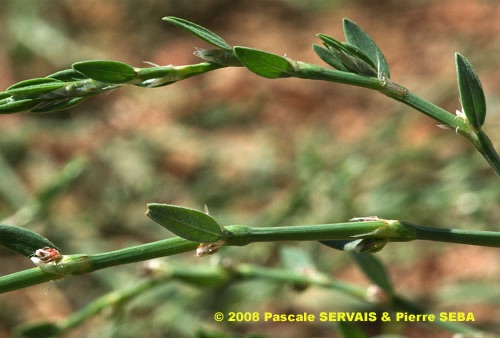
2
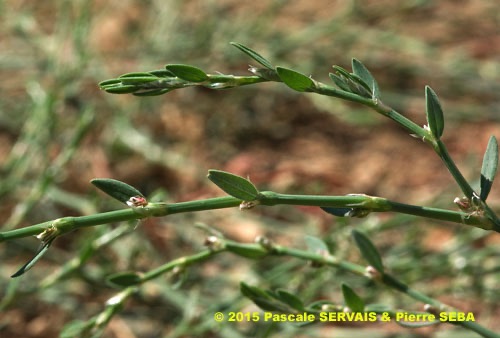
3
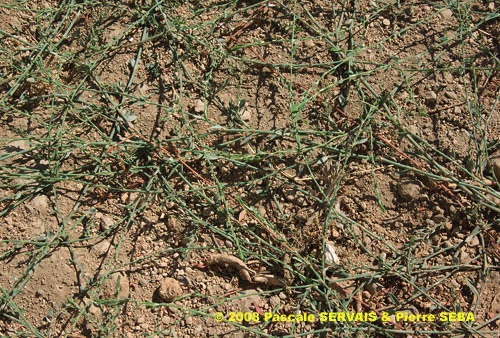
4
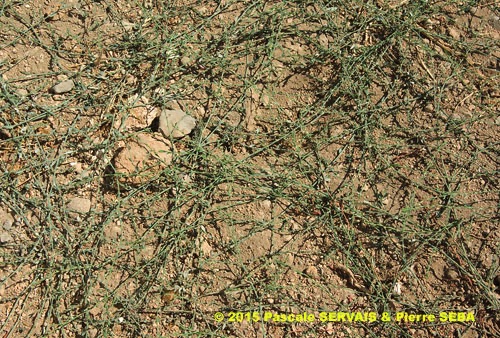
5
Étymologie / Etymology :
Polygonum : emprunt du latin polygonus, -i (nom) = la renouée, nom
donné à la plante par Pline, naturaliste latin mort en 79 apr. J.-C.,
forme latinisée du grec ancien πολύγονον, -ου (nom)
[ < πολύς, πολλή, πολύ (adj.) = beaucoup + γόνος, -ου (nom)
= l’enfant, la descendance ] = qui a une nombreuse descendance, très
fécond, nom donné à la plante par Dioscoride, médecin et botaniste
grec mort en 90 apr. J.-C., en référence à l’abondance de ses graines.
OU
emprunt du grec ancien πολύς, πολλή, πολύ (adj.) = beaucoup
+ γόνυ, γόνατος (nom) = le genou, l’articulation, le nœud d’une tige,
en référence à ses tiges très noueuses.
Aviculare : emprunt du latin médiéval avicularis, -is, -e (adj.)
[ < avis, -is (nom) = l’oiseau + -ulus (suffixe) = petit, un peu ]
= qui concerne le petit oiseau, en référence à ses graines qui servent
de nourriture aux oiseaux.
Polygonum : borrowed from Latin polygonus, -i (noun) = knotweed, name
given to the plant by Plinius, Latin naturalist died in 79 AD, Latinized
form of the Classical Greek πολύγονον, -ου (noun)
[ < πολύς, πολλή, πολύ (adj) = beaucoup + γόνος, -ου (noun)
= child, descendant ] = which has many descendants, very fruitful,
name given to the plant by Dioscorides, Greek doctor and botanist died
in 90 AD, referring to the abundance of seeds.
OR
borrowed from Classical Greek πολύς, πολλή, πολύ (adj) = many
+ γόνυ, γόνατος (noun) = knee, joint, node of stalk, referring to its
nodose stems.
Aviculare : borrowed from medieval Latin avicularis, -is, -e (adj)
[ < avis, -is (noun) = bird + -ulus (suffix) = small, a little ]
= which relates to the small bird, referring to its seeds which are eaten
by birds.
Synonymes / Synonyms :
Centinodium aviculare (L.) Fourr.
Polygonum agrestinum Jord. ex Boreau
Polygonum angustum Bellynck
Polygonum aviculare proles littorale (Link) Rouy
Polygonum aviculare subsp. agrestinum (Jord. ex Boreau) Berher
Polygonum aviculare subsp. humifusum (Jord. ex Boreau) Berher
Polygonum aviculare var. humifusum (Jord. ex Boreau) Cariot & St.-Lag.
Polygonum crispatum Gand.
Polygonum erythrellum Gand.
Polygonum flagellare Spreng.
Polygonum gnidiifolium Gand.
Polygonum humifusum Jord. ex Boreau
Polygonum hygrogenes Gand.
Polygonum lapidicola Gand.
Polygonum ligerinum Gand.
Polygonum littorale Link
Polygonum montivagum Gand.
Polygonum nanetanum Gand.
Polygonum pallens Gand.
Polygonum provinciale K.Koch
Polygonum stricticaule Gand.
Noms vernaculaires / Common names :
Noms français / French names :
Centinode — Herbe à cochon — Renouée des oiseaux —
Renouée traînasse — Traînasse.
Noms grecs / Greek names :
Πολικόμπι — Πολυγόνατο πτηνόφιλο — Σιδηρόχορτο —
Συρματόχορτο — Ψηδόχορτο.
Noms anglais / English names :
Common knot-grass — Common knotgrass — Knotgrass — Knotweed —
Prostrate knotweed — Prostrate smartweed — Wire weed.
Noms allemands / German names :
Gewöhnlicher Vogelknöterich — Vogel-Knöterich — Vogelknöterich.
Noms espagnols / Spanish names :
Centinodia — Ciennudos — Corregüela de los caminos —
Hierba nudosa — Lengua de pájaro — Sanguinaria —
Sanguinaria mayor.
Noms italiens / Italian names :
Bistorta centinodia — Bistorte aviculare — Centinodia —
Correggiola — Correggiola — Poligono centinodia —
Poligono degli uccelli.
Habitat :
Lieux incultes - Lieux humides, mares.
Waste ground - Damp places, ponds.
Île / Island :
Tilos.
Hauteur / Height range :
De 5 cm à 20 cm.
From 5 cm to 20 cm.
Floraison / Flowering time :
D’avril à décembre.
From April to December.
Groupe / Classification :
Dicotylédones.
Dicotyledons.
Pérennité / Lifespan :
Annuelle ou vivace.
Annual or perennial.
Description :
Clés dichotomiques et descripteurs distinctifs des 2 espèces / Dichotomous keys and distinctive identifying features of the 2 species
Photo 1 :
Localisation / Location : Tilos, Livadia, Village
Date : 18/09/2008
GPS : Lat. 36,41185° N / Long. 27,38891° E / Alt. 3 m
Type : Photographie numérique / Digital Photograph (10 mégapixels)
Photo 2 :
Localisation / Location : Tilos, Livadia, Village
Date : 18/09/2008
GPS : Lat. 36,41185° N / Long. 27,38891° E / Alt. 3 m
Type : Photographie numérique / Digital Photograph (10 mégapixels)
Photo 3 :
Localisation / Location : Tilos, Livadia, Village
Date : 18/09/2008
GPS : Lat. 36,41185° N / Long. 27,38891° E / Alt. 3 m
Type : Photographie numérique / Digital Photograph (10 mégapixels)
Photo 4 :
Localisation / Location : Tilos, Livadia, Village
Date : 18/09/2008
GPS : Lat. 36,41185° N / Long. 27,38891° E / Alt. 3 m
Type : Photographie numérique / Digital Photograph (10 mégapixels)
Photo 5 :
Localisation / Location : Tilos, Livadia, Village
Date : 18/09/2008
GPS : Lat. 36,41185° N / Long. 27,38891° E / Alt. 3 m
Type : Photographie numérique / Digital Photograph (10 mégapixels)

Google Maps
Google Maps
Google Maps
Google Maps
Google Maps